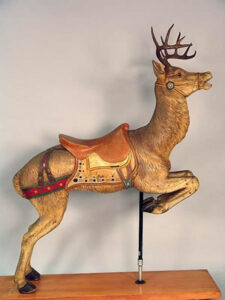 DENTZEL, GUSTAV
DENTZEL, GUSTAV
(1846–1909),
a young cabinetmaker, was among the throngs of immigrants who arrived on the shores of America in the mid-nineteenth century. Dentzel had learned his woodworking skills in his father’s shop in Kreuznach, Germany, where thefamily business had not only created fine furniture but had also built an operating carousel in the 1830s. Not long after settling in the Germantown area of Philadelphia, Dentzel decided to try his hand at the carousel business, opening G.A.Dentzel, Steam & Horsepower Caroussell Builder in 1867. His goal was to build and operate a carousel, and use it to make a living. Unfortunately, in order to generate enough revenue to stay in business, Dentzel had to move his new carousel from place to place, setting up wherever he could.By 1870, the Dentzel family had begun to grow and traveling with small children became difficult, so Dentzel started to produce more carousels, some for his ownuse as well as others he sold outright. At the time Dentzel went into production, many carousels already dotted the countryside. Yet these carousels were all produced by craftsmen or entrepreneurs who were looking to create a single ride. No one had ever gone into the business of manufacturing carousels in number until Dentzelopened his shop.Over the course of the next thirty-five years, Dentzel’s carousel business continued to grow, but as demand for his carousels increased, he became more of a businessman and less of a craftsman. Sons William and Edward and nephew Harry soon became integral members of the carving crew and business staff.The style of the carvings produced at Dentzel’s company evolved under the creative influence of such master carvers as Charles Leopold, Daniel Müller (1872– 1951), and Salvatore Cherny (Cernigliaro) (1879–1974). The carvings became much more intricate, and a wide variety of animals were added to the Dentzel stable of carousel figures. By 1905, Dentzel’s company was producing the most realistic as well as the most fanciful of designs to ever grace a carousel.Gustav died in 1909, leaving the business to his oldest son, William. After the estate was settled, William reopened the business as the William H.Dentzel Co., eventhough the style of the carvings varied little. The carousel business began to fade with the advent of World War I. In 1928 William died, and the business closed itsdoors for good.
See also
Carousel Art; Salvatore Cherny; Daniel Müller; Sculpture, Folk
.
BIBLIOGRAPHY
Dinger, Charlotte.
Art of the Carousel.
Green Village, N.J., 1983.Fraley, Tobin.
The Carousel Animal.
San Francisco, 1983. ——.
The Great American Carousel.
San Francisco, 1994.Fried, Frederick.
A Pictorial History of the Carousel.
Vestal, N.Y., 1964.Mangels, William F.
Outdoor Amusement Industry.
New York, 1952.McCullough, Edo.
Good Old Coney Island.
New York, 1957.Stevens, Marianne.
Painted Ponies.
New York, 1986.Summit, Roland.
Carousels of Coney Island.
Rolling Hills, Calif., 1970.Weedon, Geoff.
Fairground Art.
New York, 1981
